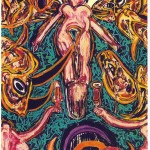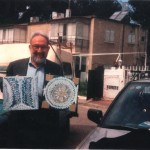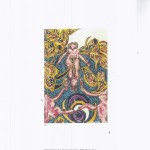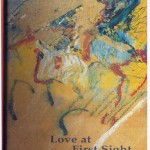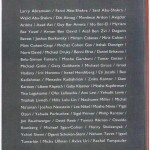"אהבה ממבט ראשון"
אוסף ארתורו שוורץ במוזיאון ישראל ירושלים
אוצר: אמיתי מנדלסון
:טקסט על עבודותיה של רחל אורי ימפולר מאת פרופסור ארטורו שוורץ
Rachel Yampouler
Rachel Yampouler was born in Tel Aviv where she now also teaches literature. She studied art with her mother Aviva Uri and David Handler and graduated from Tel Aviv University where she studied literature and art history. Her first solo exhibition was held in1992 at the Sara Erman Gallery in Tel Aviv.
- תמונת הציירת באוסף
- פרופ' ארטורו שוורץ עם תמונות הציירת
- דף קטלוג האוסף עם תמונת הציירת
- כריכת קטלוג האוסף (1)
- כריכת קטלוג האוסף (2)
Yampouler has had to grapple with the handicap of being the daughter of a mythical figure of thy Israeli art scene, the explosive painter Aviva Uri, who died suicide at thy age of sixty-two. Notwithstanding this impediment, exacerbated by the fact that her studio is crammed not only with her own works but also with those of her mother, she has contrived to develop a fully personal style and to give expression to a world of emotions, sensations, dreams, desires and resentments that are strictly her own.
In a november 1994 letter to me, Yampouler recounted how difficult it had been for her to overcome this situation and how long it took to assert her individuality: "I commenced my artistic endeavours with an entire year spent just painting Aviva's portraits. After that, I remember the act of liberation when I took the canvas with "the most beautiful" portrait of hers I had exevuted' and "sacrificed" it, over painting the portrait with my first autonomous work, as an act of ingestion (recalling Raushenberg's act in erasing de Kooning). Only recently have I found myself capable of acknowledging that I am an artist in my own right, and that I have something to say. Of course, I shunned paper and line, because that was my mother's territory (only now, in my present exhibition, (1994) have I found the courage to sketch and return to the line)" (idem).
What Yampouler inherited from her mother is the dual irrepressible call to paint and study: "The urge to paint and touch the material has always been firt in my belly. Painting and art are an existential requirement, an organic need like loving or eating… What I share with her is my incessant effort to recharge myself with knowledge. I read and study constantly, in an effort to keep my finger on the pulse of present day culture" (idem).
Her palette is dominated ny garish colours, nervously applied with throbbing brushstrokes that to a large extent obey the dictates of psychic automation. Her free flowing, intensely passionate images are alternately abruptly direct of visionary. Yampouler acknowledges the debt she owes to the surrealist's ambition to express the actual functioning of thought "in the absence of any control exercised by reason (and) exempt from any aesthetic or moral concern" (Breton 1924:26), she thus told me: "I work "witout reckoning" in a kind of ecstasy… To me creativity is a love ritual (alluded to in the East as insight).When at work, I am unaware of what I am doing – an artist taking herself by surprise. My work on the whole is of a meditative nature" (idem).
In Etant Donne Twice, 1990, Rachel Yampouler interprets, in the light of acutely feminine sensibility, the Bride who, in Marcel Duchamp's celebrated environment Etant Donne… 1946-66, exposes herself, invitingly nude, to the stare of her lover. in Duchamp's over a single gas lamp, held aloof by the Bride, illuminates her nudity. Here, two female attendants, each holding a gas lamp, are poised at the bottom of the composition the better light the stripped Bride, while phantom like, goggling eyes hover all around the nude threatened by the horns of a rhino.
In may of Yampouler's works, surfaces the theme of Duchamp's famous masterpiece the Bride Stripped Bare by Her Bachelors, even, 1915-23, (known for short as The Large Glass), which constitutes the first part of the 50-year long love poem finding its happy conclusion in Etant Donne…
Let us recall that, while in Large Glass the Bachelor is confined to a voyeuristic role, in the 1946-66 environment hid courtship is finally rewarded.
In another work of this series, Yampouler painted on each side of the Bride – with whom she identifies – Duchamp's two castrating machines: The Chocolate Grinder, 1914 and the Coffee Mill, 1911. We are aware that, in the esoteric tradition, the castrated individual represents the asexual condition of the initiated who is endowed with the golden awareness and thy creative power that goes with it. Erich Neumann has thus pointed out that castration "is the condition of all creation"(1949:121). In her letter to me, commenting these works, Yampouler perceives the illuminating connotation of castration: "It could be argued that I castrate and disfigure myself, possibly for the purpose of reconstituting myself, when, I shall emerge from that disintegration to arrive at the creation of a new person liberated of thy phobia and dread of the empty hole."
The undisguised depiction of the female and male genitals, that are recurring elements in her pictures, should not be interpreted as an attempt to scandalize the viewer, they are rather a forceful reminder of their original sacred nature and of the necessity to acknowledge the importance that the sexual intinct – responsible for human civilization according to Freud, has in our daily life.
Ultimately, Yampouler's frank and overt treatment of the question is but another way to claim for women the same privileges enjoyed by men.

